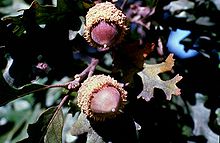- Quercus macrocarpa
-
"Bur Oak" redirects here. For places named after the oak, see Burr Oak (disambiguation).
Bur Oak 
Bur Oak leaves and acorn Conservation status Scientific classification Kingdom: Plantae (unranked): Angiosperms (unranked): Eudicots (unranked): Rosids Order: Fagales Family: Fagaceae Genus: Quercus Section: Quercus Species: Q. macrocarpa Binomial name Quercus macrocarpa
Michx.
Quercus macrocarpa, the Bur Oak, sometimes spelled Burr Oak, is a species of oak in the white oak section Quercus sect. Quercus, native to North America in the eastern and midwestern United States and south-central Canada. This plant is also called Mossycup oak and Mossycup white oak.
It occurs from the Appalachian Mountains west to the middle of the Great Plains, extending to central Texas, across southernmost Manitoba, Ontario and Quebec, east to the Atlantic Coast in southern New Brunswick and down the coast to Delaware. Bur Oak is the state tree of Iowa.
It is a large deciduous tree growing up to 30 m (100 ft), rarely 37 m (120 ft), in height, and is one of the most massive oaks with a trunk diameter of up to 3 m (10 ft); reports of taller trees occur, but have not been verified. It is one of slowest-growing oaks, with growth rate of 30 cm (1 ft) per year when young. A 20-year-old tree will be about 6 m (20 ft) tall. It commonly lives to be 200 to 300 years old, and may live up to 400 years. [1] The bark is a medium gray and somewhat rugged.
The leaves are 7–15 cm (3–6 in) long and 5–13 cm (2–5 in) broad, variable in shape, with a lobed margin. Most often, the basal 60% is narrower and deeply lobed, while the apical 40% is wider and has shallow lobes or large teeth. The flowers are greenish-yellow catkins, produced in the spring. The acorns are very large, 2–5 cm (0.8–2 in) long and 2–4 cm (0.8-1.5 in) broad, with a large cup that wraps much of the way around the nut, with large overlapping scales and often a fringe at the edge of the cup.
Bur Oak is sometimes confused with Overcup oak and White oak, both of which it occasionally hybridizes with.
Contents
Ecology
Bur Oak typically grows in the open, away from forest canopy. For this reason, it is an important tree on the eastern prairies, where it is often found near waterways in more forested areas, where there is a break in the canopy. It is also a fire-resistant tree, and possesses significant drought resistance by virtue of a long taproot. New trees may, after two to three years of growth, possess a 1–2 m deep taproot. The West Virginia state champion Bur Oak has a trunk diameter of almost 3 m (9 feet).
The acorns are the largest of any North American oak (thus the Latin species name macrocarpa--large fruit), and are an important wildlife food; American Black Bears sometimes tear off branches to get them. However, heavy nut crops are borne only every few years. In this strategy, known as masting, the large seed crop every few years overwhelms the ability of seed predators to eat the acorns, thus ensuring the survival of some seeds. Other wildlife, such as deer and porcupine, eat the leaves, twigs and bark. Cattle are heavy browsers in some areas. The bur oak is the only known foodplant of Bucculatrix recognita caterpillars.
Cultivation and uses
Bur oak makes an outstanding ornamental tree. It is one of the most tolerant of urban conditions of the white oaks, and is one of the fastest-growing of the group. It has been planted in many places north to Anchorage, Alaska and as far south as Mission, Texas. It withstands chinook conditions at Calgary, Alberta.
The wood is high quality, and is almost always marketed as "white oak".
The name sometimes is spelled "burr oak", as for example in Burr Oak State Park in Ohio, the city of Burr Oak, Kansas, the village of Burr Oak, Michigan, and in the title Burr Oaks by poet Richard Eberhart.[citation needed]
It is also less commonly called "burl oak", as in the Burl Oaks Country Club in Mound, Minnesota.[citation needed]
Chemistry
The dehydrated tergallic acid C-glucoside and tergallic acid O-glucoside can be characterised in the acorns of Q. macrocarpa.[2]
References
- Sternberg, G. (1998). Quercus macrocarpa. 2006. IUCN Red List of Threatened Species. IUCN 2006. www.iucnredlist.org. Retrieved on 6 May 2006.
- Flora of North America: Quercus macrocarpa
- USDA Plants Profile: Quercus macrocarpa
- Quercus macrocarpa images at bioimages.vanderbilt.edu
External links
Categories:- IUCN Red List least concern species
- Quercus
- Trees of humid continental climate
- Trees of Canada
- Trees of Southeastern Canada
- Trees of Ontario
- Trees of Manitoba
- Trees of Saskatchewan
- Trees of the United States
- Trees of the Plains-Midwest (United States)
- Trees of the Northeastern United States
- Flora of Massachusetts
- Trees of Michigan
- Trees of Alabama
- Trees of North Carolina
- Least concern plants
- Trees of Kentucky
- Trees of Ohio
Wikimedia Foundation. 2010.




